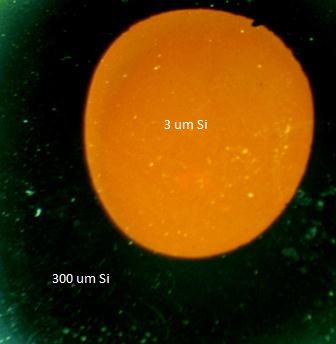
The focus of the PLATOS project is on ways to increase the light absorption in silicon-based, thin-film solar cells.
The current market for commercial solar cells is dominated by 1st generation monocrystalline and multicrystalline Si-solar cells. One drawback of these solar cells is that relatively thick (~300-400 µm) layers of Si are needed, and the electrical quality of this Si has to be very high in order to ensure a sufficient solar power conversion efficiency. As a consequence the price of energy produced by modern commercial Si-solar cells is still not competitive, although substantial technological progress and cost reductions are seen these years.
Thin-film Si-solar cells, which are made of thin Si layers (~1-2 µm), can be produced substantially cheaper due to the smaller amount of Si used. Moreover, the reduced thickness also means that Si of lesser electrical quality, such as amorphous Si, can be utilized. However, the reduced thickness comes at the expense of solar power-conversion efficiency, which for the thin film solar cells is substantially reduced – only 5-8 % compared to 14-18% for the commercial 1st generation solar cells. This reduction in efficiency is caused by an insufficient light collection in the thin film cells (see figure 1) and is the main challenge of thin-film solar cell technologies.
In order for thin film solar cells to be become more efficient, it is necessary to reduce the losses due to the transmission of the red light. A number of techniques for trapping light in solar cells are already known, but many of them are not transferrable to thin-film Si cells due to the very thin films used.
The PLATOS project aims at investigating and developing light trapping and absorption enhancement effects in Si solar cells, which are based on the interaction of light with metallic nanoparticles via excitation of localized surface plasmons.
A localized surface plasmon is a collective oscillation of the electron density in the small particles, which is a result of the coulomb interaction between the free electrons in the metal nanoparticle. When the metal nanoparticles interact with light they scatter the incident light like small dipole-antennas into a wide angular distribution, and this scattering effect can be substantial if the frequency of the incident light is resonant with the plasmon resonance. In addition, a large near-field exists close to the particles at resonance, which may be exploited to increase the absorption very close to the nanoparticles, and thus transfer light absorption in the far field into absorption in a volume much smaller than the wavelength of the light.
Both of these two types of interactions are studied in both thin silicon layers (either epitaxial or nanocrystalline/amorphous silicon layers) in the PLATOS project.
External Participants
Department of Physics and Nanotechnology, Aalborg University (AAU).